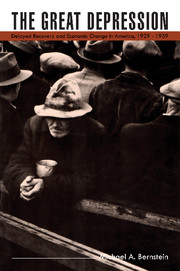Book contents
- Frontmatter
- Contents
- List of tables
- List of figures
- Editors' preface
- Preface
- Introduction: The puzzle of the 1930s
- 1 Long-term economic growth and the problem of recovery in the United States, 1929–39
- 2 The transformation of American industry in the interwar period
- 3 A reassessment of investment failure in the interwar economy
- 4 Technical change during the interwar years
- 5 The effective demand problem of the interwar period. I: Cyclical and structural unemployment
- 6 The effective demand problem of the interwar period. II: Cyclical and secular changes in final demand
- 7 New Deal economic policy and the problem of recovery
- 8 Contemporary economic problems in historical perspective
- Bibliography
- Index
2 - The transformation of American industry in the interwar period
Published online by Cambridge University Press: 06 July 2010
- Frontmatter
- Contents
- List of tables
- List of figures
- Editors' preface
- Preface
- Introduction: The puzzle of the 1930s
- 1 Long-term economic growth and the problem of recovery in the United States, 1929–39
- 2 The transformation of American industry in the interwar period
- 3 A reassessment of investment failure in the interwar economy
- 4 Technical change during the interwar years
- 5 The effective demand problem of the interwar period. I: Cyclical and structural unemployment
- 6 The effective demand problem of the interwar period. II: Cyclical and secular changes in final demand
- 7 New Deal economic policy and the problem of recovery
- 8 Contemporary economic problems in historical perspective
- Bibliography
- Index
Summary
There was abundant capital in the country and a mass of unemployed labor. But the markets on which they had of late depended … were overworked and overstocked … and capital and labor wanted “a new channel.”
– Benjamin Disraeli, Earl of BeaconsfieldIn macroeconomic terms, the impact of the Great Depression on the United States is well known. From the stock market collapse in late 1929 until the middle of the thirties, the physical output of goods and services contracted by 33%. Almost 25% of the labor force was idled. Capital accumulation came to a standstill – one investigator has even reported a negative rate of net investment for the decade 1929–39. This broad outline of the nation's worst economic misfortune has been the focus of almost all the theoretical and historical work done on the depression.
Despite the large amount of aggregate data that has been examined, there remain many unanswered questions concerning the course of the Great Depression in the United States. The differential effects of the slump on regions, on industries, and on classes of income recipients are but a few of the missing parts in the received scenario. Moreover, little attention has been paid to the experience of particular industries.
- Type
- Chapter
- Information
- The Great DepressionDelayed Recovery and Economic Change in America, 1929–1939, pp. 48 - 102Publisher: Cambridge University PressPrint publication year: 1987

